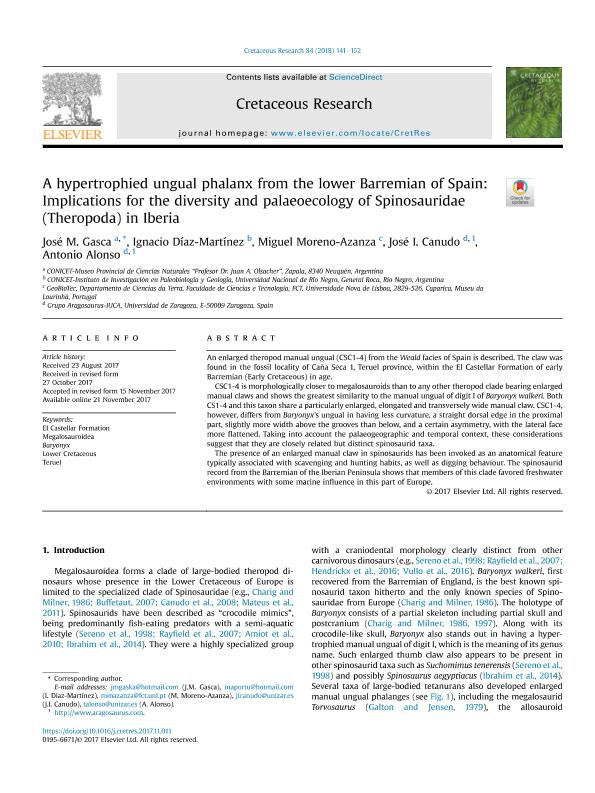Artículo
A hypertrophied ungual phalanx from the lower Barremian of Spain: Implications for the diversity and palaeoecology of Spinosauridae (Theropoda) in Iberia
Gasca Pérez, José Manuel ; Díaz Martínez, Ignacio
; Díaz Martínez, Ignacio ; Moreno Azanza, Miguel; Canudo, José I.; Alonso, Antonio
; Moreno Azanza, Miguel; Canudo, José I.; Alonso, Antonio
 ; Díaz Martínez, Ignacio
; Díaz Martínez, Ignacio ; Moreno Azanza, Miguel; Canudo, José I.; Alonso, Antonio
; Moreno Azanza, Miguel; Canudo, José I.; Alonso, Antonio
Fecha de publicación:
04/2018
Editorial:
Academic Press Ltd - Elsevier Science Ltd
Revista:
Cretaceous Research
ISSN:
0195-6671
Idioma:
Inglés
Tipo de recurso:
Artículo publicado
Clasificación temática:
Resumen
An enlarged theropod manual ungual (CSC1-4) from the Weald facies of Spain is described. The claw was found in the fossil locality of Caña Seca 1, Teruel province, within the El Castellar Formation of early Barremian (Early Cretaceous) in age. CSC1-4 is morphologically closer to megalosauroids than to any other theropod clade bearing enlarged manual claws and shows the greatest similarity to the manual ungual of digit I of Baryonyx walkeri. Both CS1-4 and this taxon share a particularly enlarged, elongated and transversely wide manual claw. CSC1-4, however, differs from Baryonyx's ungual in having less curvature, a straight dorsal edge in the proximal part, slightly more width above the grooves than below, and a certain asymmetry, with the lateral face more flattened. Taking into account the palaeogeographic and temporal context, these considerations suggest that they are closely related but distinct spinosaurid taxa. The presence of an enlarged manual claw in spinosaurids has been invoked as an anatomical feature typically associated with scavenging and hunting habits, as well as digging behaviour. The spinosaurid record from the Barremian of the Iberian Peninsula shows that members of this clade favored freshwater environments with some marine influence in this part of Europe.
Palabras clave:
BARYONYX
,
EL CASTELLAR FORMATION
,
LOWER CRETACEOUS
,
MEGALOSAUROIDEA
,
TERUEL
Archivos asociados
Licencia
Identificadores
Colecciones
Articulos(CCT - PATAGONIA NORTE)
Articulos de CTRO.CIENTIFICO TECNOL.CONICET - PATAGONIA NORTE
Articulos de CTRO.CIENTIFICO TECNOL.CONICET - PATAGONIA NORTE
Articulos(IIPG)
Articulos de INSTITUTO DE INVESTIGACION EN PALEOBIOLOGIA Y GEOLOGIA
Articulos de INSTITUTO DE INVESTIGACION EN PALEOBIOLOGIA Y GEOLOGIA
Citación
Gasca Pérez, José Manuel; Díaz Martínez, Ignacio; Moreno Azanza, Miguel; Canudo, José I.; Alonso, Antonio; A hypertrophied ungual phalanx from the lower Barremian of Spain: Implications for the diversity and palaeoecology of Spinosauridae (Theropoda) in Iberia; Academic Press Ltd - Elsevier Science Ltd; Cretaceous Research; 84; 4-2018; 141-152
Compartir
Altmétricas



